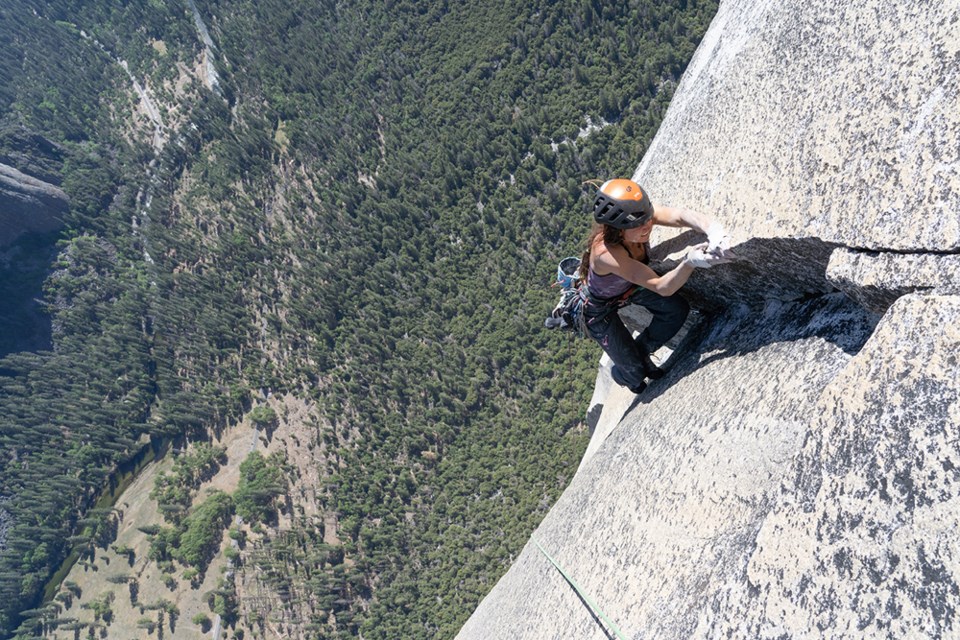A local climber is now among only three other female athletes who have conquered the Golden Gate route on El Capitan, in Yosemite National Park, Calif., as free climbers — using just their hands and feet, without the help of pulling on aid gear.
Squamish’s Bronwyn Hodgins can count herself in that very exclusive club, consisting of herself and two other world-class climbers — Hazel Findlay and Emily Harrington.
At first, it did take her a little bit of time to adjust to the reality of being in such company.
Knowing that the only two other women who completed the climb were world-famous, she felt like an imposter, she said with a laugh.
“That definitely added to the intimidation factor when I was setting myself up for this goal,” she said.
However, if she felt like an imposter, it certainly didn’t impact her performance.
Between May 5 to 13, Hodgins worked her way up the 34-pitch route, which stands at about 909 metres and is graded 5.13. For reference, the easiest beginner routes are graded at about 5.6 while the hardest routes are about 5.15. An athlete who can complete 5.12 is considered exceptional.
With this accomplishment, Hodgins finds herself as being exceptional among the exceptional.
“It was the perfect level of challenge. I think I’m someone who really wants to push myself and see what I’m capable of doing,” said Hodgins.
“The epitome of goal-setting is finding a goal that is really ambitious, but only just possible and then, in the end, you either just barely don’t manage it or just barely manage it. It’s pretty rare to find a goal that’s at that perfect level for you.”
For the Squamish climber, the biggest challenge lay with four crux pitches — or sections — that were of greatest difficulty, which also happened to be near the top of the route.
The challenge in this case was to complete the majority of the route — an exhausting task in of itself — and then have to deal with hardest parts close to its end.
“For me, it was like, I need to send these four cruxes. And I don’t only need to send them, full stop — I need to send them when I’m tired and without having very many [attempts],” said Hodgins.
“Because if I spend 20 attempts doing the first crux, I won’t have anything left for the other three.”
To get ready for the ascent, Hodgins arrived a month before the climb. She wound up hiking to the very top of El Capitan with 300 metres of rope and rappelling down so she could see and work out the hardest parts of the route, bit by bit.
She realized that the main challenges of the ascent for her would be two of the four crux pitches.
“Two of the pitches were quite endurance-based. [They] have long, sustained, pumpy pitches, which tends to be my style. I’m an endurance climber. I climb long routes. I can hold on forever,” said Hodgins.
“But what I find more my weakness in climbing is doing hard moves...I don’t really boulder that much. I just find hard crux sequences really hard.”
In other words, the main challenge would be conquering segments where the name of the game wasn’t endurance, but rather a small number of bouldering-type moves that favoured sheer strength.
These consisted of a handful of moves that could take days to dial in. Some were so difficult that Hodgins couldn’t even perform them initially.
“The first time I rapped all the way in there, I tried the pitch and I didn’t do the move. I wasn’t able to do the main shoulder lock-off move, or the move to get into the shoulder lock-off move. It was definitely, like, a snag,” she said with a laugh.
But it was only a temporary one.
She’d soon after drill the moves until she could ascend that section multiple times.
But her time working out sequences in Yosemite was just the last stage of preparation.
Hodgins has had her eye on the route since last year.
As a result, she’d begun training in the fall and winter months, putting in time sport climbing in St. George, Utah. She was climbing virtually full time to prepare, a schedule made possible as a result of money she saved while working as a guide, along with partnerships she has with various outdoor companies.
Hodgins said one key aspect of her training process involved looking at difficult routes and mentally rehearsing the climb so she could successfully ascend in as few attempts as possible.
This was key to her success in Yosemite, she said, because she had to find a means to climb the hardest sections of the route quickly, so as to avoid tiring herself out completely.
In the end, Hodgins said that the key to embarking on a giant goal like this one was a win-win mindset.
The idea, she said, is that if she tries as hard as she can and succeeds, it’s a win. If she tries as hard she can and still fails — it’s still a success, as it becomes great training for the next attempt.
“With that sort of mindset, then, I think it’s less intimidating and less scary to push yourself on something that feels really ambitious,” Hodgins said.


